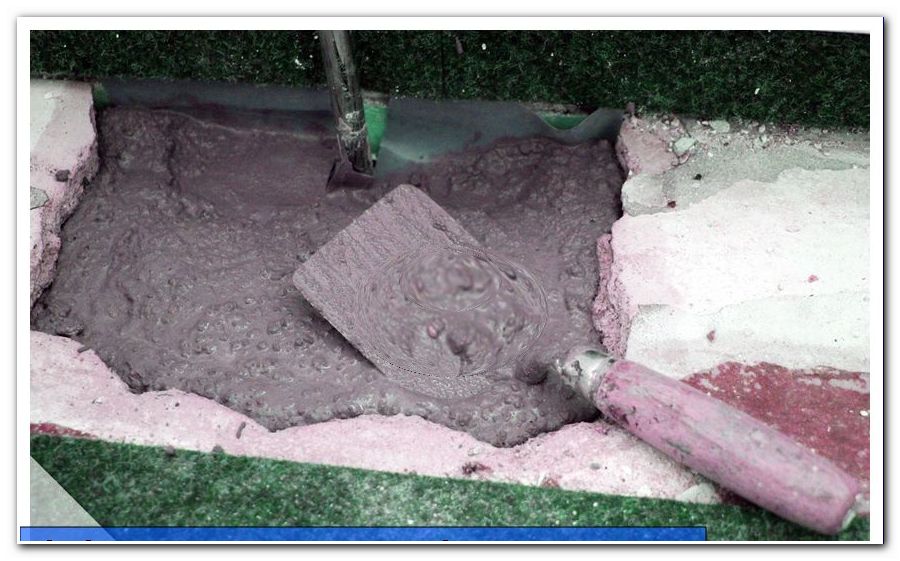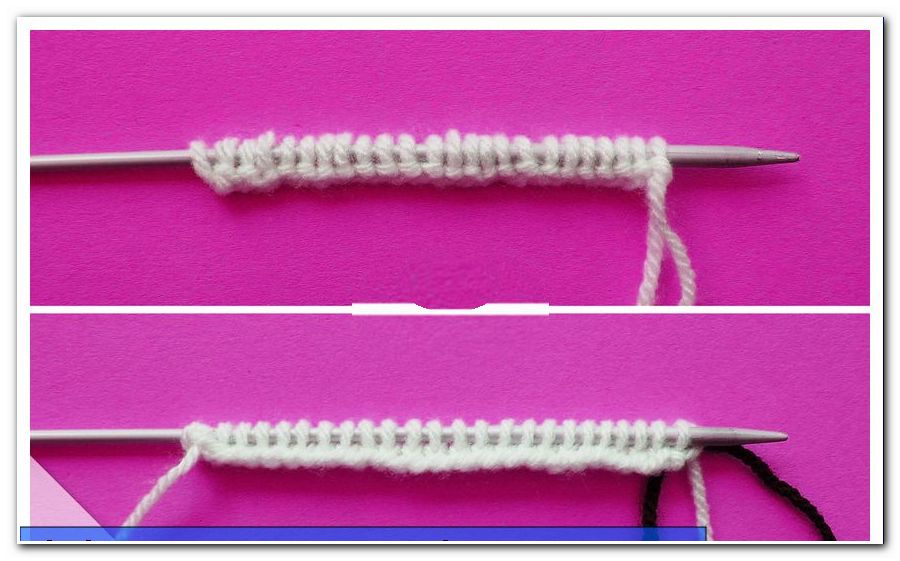Ventilate old and new radiators properly - DIY instructions

- Ventilation of the central heating
- Bleed valves and systems
Whether gas or oil heating, in the radiators always accumulates some air during the year. As a result, the radiator is no longer really warm and the heating costs are higher than necessary. With minimal effort, however, the radiator and the heating system can be vented. Here we show the appropriate instructions for the ventilation of any type of radiator.
Once the heating season starts again, the collected air in the radiators unpleasantly noticeable. The radiators are just warming up or they are knocking and bubbling. The heater can not work effectively. Although the boiler or heating system supplies hot water to the radiators, because they are full of air, the warm water can not spread in it. But as the thermostat continues to report a need to the heater, it is working more and more. Of course, the heating costs also increase steadily, without you having any of it. Cuddly warm and quiet your radiators but by a simple vent.

You need this:
- Square key
- Wasserpumpenzange
- small bowl
- towel
- screwdriver
- Ventilate radiators - save energy
Whether ribbed or panel radiator, in most cases the venting valve is exactly opposite the thermostat. Conventional valves on plate or ribbed radiators can be opened with a simple small square wrench. The order of the ribbed radiators, which you ventilate, is important because the air is distributed through the pipe system to the last ribbed radiator.

Tip: If you do not have a square key in the house, there is the small practical tool for one or two euros in the nearest hardware store. Avoid opening the valve with pliers, as this will damage the square. Later, the square valve is round and can not open normally. If you have purchased new square wrenches, you should make them hang with a piece of colorful gift ribbon. Then always hang the small key in the meter box for the power. If the square key has found such a firm place, it is hardly lost.
Ventilation of the central heating
In our first manual you will find the order in which a normal heating valve is vented. Afterwards we will show you the possibilities to bleed older unusual valves. Do not forget then that you usually have to refill the water in the heating system after airing.

Tip: The best order for bleeding is from bottom to top. But even within a floor, you should act in order. So the nearest plate or finned radiator from the heater is the first candidate on your list. However, there are older houses that only have a vent valve for all radiators. You will find below the instructions how you and the other residents of a multi-family house can vent the heating in this case.
1. Turn off circulation pump or heating circuit
If possible, stop the circulation pump before venting. The running pump otherwise swirls around in the radiators and in the pipe system still much air around. Later, some of the air comes out of the radiators, but most of it is still whirling around in the system. You would have to bleed the system again and again. If there is no possibility to switch off the circulation pump, you should switch off the heating circuit or at least close all thermostats.
2. Turn on the thermostat
After one to two hours, the air has usually set off a bit and you can turn on the circulation pump again and fully open the thermostats. Wait until the hot water flows into the convector. Then hold a small bowl or a thick towel under the valve.

Tip: There are small sets in the hardware stores that contain the key and a small cup with a hanging device. This is then hung over the vent valve and you have your hand free to gently open the vent valve.
3. Radiator venting
With the small key, turn the valve slightly counterclockwise. For a moment the air will fizzle out, then a little warm water will come. This is the right time to close the valve. If you perform the bleeding at least once a year, it will usually not be necessary to repeat the procedure the next day. Nevertheless, check whether the heating coil now heats up completely.

Tip: If all panel and finned radiators are completely vented, the pressure in your heater may have dropped sharply. Then you should top up with water in the heating system. On the heater there is a pressure gauge on which the pressure is displayed. The pointer should be in the green area. If the pressure has dropped, the heating would have to be filled up with water. In the manual of your heating system you will find the exact instructions how to top up the water in the heater. In most cases, a yellow hose is also hung next to the heater that you need.
Bleed valves and systems
There seemed to be a time when there was some growth in the vent valves. For example, if you have an older house, you may still have round radiator valves that are about the size of a dime and are heavily grooved around the edge. These vent valves were installed almost exclusively on older ribbed radiators. These valves can be opened in the same way as the square valve. However, they are often difficult to turn, so you need pliers instead.
- Place rag around the breather valve for protection
- with water pump pliers open heating valve slightly
- wait until water comes out
- Close the heating valve again
Another heating valve, which can still be found today, is not opened with a key, but quite simply with a wide flat-head screwdriver . Although at first glance a similar valve as the square valve is installed, but on closer inspection, it can be opened a little differently. Otherwise, the plate or ribbed radiators are vented with these valves but just as described above.

Tip: The towel radiator is a special form of the modern valves. Here you will often find the valve not opposite the thermostat, but at the top in the opposite corner and partly a little backwards. It can be opened easily with the square key.
One for all - a radiator valve for the whole house: In old houses, although the heating is often renewed itself, but not the good old ribbed radiators or the pipe system. In some houses from the turn of the century, there are also the original ribbed radiators for reasons of historic preservation, some of which do not have their own ventilation valves. In these houses then a single valve is mounted on the top floor either on the heating pipe or one of the ribbed radiator has a venting device. There is also the possibility that later in the bathroom a panel radiator was additionally grown, which then also takes over the complete ventilation of the heating system.
Plate or ribbed radiators without ventilation: In the case of an older radiator without a ventilation valve, it is still possible to vent the ribbed radiator via the thermostat. If you have no experience in DIY or plumbing, but you should leave this task to a specialist.
- Close the thermostat completely
- Unscrew the thermostat with the water pump pliers
- Push in the thermostatic valve (small pin) until air escapes
- with some thermostatic valves you have to loosen the big square slightly until the air escapes
- The thermostat is turned on completely and then put back on

Tip: If you remove the thermostat, it should be completely closed, ie turned off. When the thermostat is reinstalled, it should be completely open. The small pin that controls the thermostatic valve is operated by a spring inside. So if the thermostat is dismantled, the spring pushes out the small pin and the radiator takes up hot water. That's why you can not leave a rib or plate radiator without a thermostat. There must always be at least one so-called construction valve or a construction fastener on the regulator so that it closes, or the pin is pushed in.
Case study - old and new
Only recently did we see a nice mish-mash of systems in an older house. In this case, one half of the house is new and equipped with new panel radiators and a new pipe system. Here there is peace, although this part of the same heating system is supplied. In the older part is the new heating. However, just under the ceiling, the thick old pipes run through the hallway. These enjoy the residents especially at night with heavy knocking and gargling. Even when all the ribbed radiators in the old area were vented, the pipes gave no rest. Until the residents in the bathroom discovered two valves behind the back wall of a built-in closet. Obviously, the old pipe system can be additionally vented via these valves.
Tip: So, if you have a similar problem, follow the paths of the tubes once exactly. The plumbers used to be quite inventive in terms of attaching the venting options. That was perfectly okay, but unfortunately in the older houses, the owners have changed more frequently, so today no one knows where these vents are.
Tips for quick readers:
- Turn off the circulation pump or heating circuit as much as possible
- Wait for about an hour until air calms down
- Turn on radiator fully
- Keep towel or bowl under valve
- Open air valve counterclockwise
- wait until water comes
- repeat if necessary one day later
- Add water to the heater
- looking in old homes vent valve
- possibly only vent valve on the upper floor
- Bleeding may take longer / longer distances
- possibly perform more often
- in between refill with water
- Bleed heater without venting via thermostatic valve
- possibly hire a specialist




